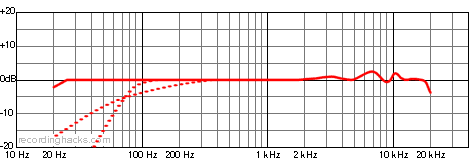 Shure KSM32
Shure KSM32
Cardioid Condenser Microphone
The Shure KSM32 is a side-address, cardioid condenser microphone. It uses an electret capsule design and transformerless output.
The single diaphragm is a gold-layered 2.5 micron Mylar design. It is not a large diaphragm, according to the traditional definition of “large” as “1 inch diameter.” However, Shure claims the 0.75''-diameter diaphragm in the KSM32 confers other benefits:
Shure
[Benefits] include extended high frequency response, improved linearity and more consistent polar response at high frequencies… By combining a .750'' diaphragm with embossing technology, the KSM32 is able to provide rich, smooth lows and balanced reproduction of any source without sacrificing clarity.
The Mylar diaphragm is embossed — stamped to produce a textured surface — increasing the surface area. This increases the low-frequency response of the diaphragm, and makes it better able to withstand changes in environmental conditions such as temperature and humidity*.
As on the KSM27 and KSM44, a 3-stage mesh pop filter built into the headbasket reduces breath and wind noise. An internal shock mount reduces handling noise. In addition, a 15dB pad switch is available on the mic body, as well as a 3-position high pass filter:
- flat
- -15dB per octave at 80Hz (Low frequency “cutoff”)
- -6dB per octave at 115Hz (Low frequency “rolloff”)
As with the other KSM mics, the electronics are Class A; the FET preamp does not use a transformer.*
Shure
With careful design, solid state technology can benefit from transformers by providing improved RFI/electrostatic immunity, excellent common-mode rejection ratio, solutions for ground-loop problems, and induced common mode power line interference.
However, the penalty of using transformers can be costly. High quality transformers tend to be expensive and have large footprints… smaller transformers are often used resulting in limited dynamic range and unpleasant distortion at usable levels… These transformers typically do not provide the expected benefits. High parasitic capacitance, unbalanced windings, and poor construction of transformers make the device susceptible to hum from power lines…
The KSM32 uses transformerless circuit design. Shure has developed a balanced solid state preamplifier circuit that has virtually all the benefits of a high-quality transformed design without the drawbacks associated with smaller, cost effective transformers. The interface of the microphone is equipped with RFI protective ferrite beads and chokes. These parts prevent leakage of a wide range of radio frequency signals into the microphone?s circuitry, but are transparent to differential audio signals coming from microphone. As a result of careful attention to the interface design, the immunity of the KSM32 to interference and electrostatic shock is better or as good as the best microphones that use high quality transformers.
The KSM32 is packaged two ways:
- KSM32/SL - champagne finish; includes locking aluminum case, mic clip, spider shockmount, soft pouch
- KSM32/CG - charcoal-gray finish, mic clip, soft pouch
Note that the grille design of the KSM32 has changed slightly since its introduction. To differentiate it visually from the KSM44, a coarser grille design replaced the original. Shure claims this change is purely cosmetic.*
SoundOnSound
The supplied frequency plot appears to be commendably flat across most of the frequency range, but a few wobbles appear in the region between 2kHz and 10kHz. There are essentially two 3dB peaks at about 7kHz and 10kHz (the upper one being rather narrower than the lower one), with a mild suck-out at 9kHz. All in all, it’s the kind of frequency balance which would tend to add a little musical presence and clarity to most sources.
In the price/performance ratings I would give the KSM32 a solid 10… This may end up being Shure’s workhorse for the next 20 years.
How is the KSM-32 different from the KSM-27? How is the KSM-32 different from the KSM-44?
The KSM27 and KSM44 are very similar, and both differ from the KSM32 in several respects, so we’ll address these questions together.
The KSM32 is an electret, or permanently polarized condenser design, whereas the KSM27 and KSM44 use an externally-polarized or “true” condenser design*.
The KSM27 and KSM44 are billed as having a “warm” sound, whereas the KSM32 is described as “neutral.”*
All three KSM mics have a gold-plated 2.5 micron Mylar diaphragm, but it is smaller (0.75'') in the KSM32. Further, the KSM32 diaphragm is embossed as described above.
The KSM27 and KSM32 have comparable levels of self-noise, whereas the KSM44 is 5 dB quieter*.
The KSM32 and KSM44 bodies are nearly identical in size, shape, and weight. The KSM27 is smaller but heavier.
The Shure KSM32 is also known as: KSM-32, KSM32/SL, KSM32/CG.
The mic was released in 1998.
Specifications
| Frequency Response - CardioidClick Graph to Compare! |
|---|
 |
| Pickup Patterns | Pads & Filters |
|---|---|
|
Cardioid
(16 mV/Pa; 20 - 20,000 Hz) |
|
| Capsule Dimensions | Impedance | SPL/Noise |
|---|---|---|
| Diaphragm diameter: 19mm |
150 Ohms (Low) | Max SPL: 154 dB Self-noise: 13.0 dB(A) |
| Weight | Length | Max Diameter | Interface(s) |
|---|---|---|---|
| 490g (17.28oz) | 187mm (7.36'') | 56mm (2.20'') |
|
| Power Specifications |
|---|
|
Did we get anything wrong on this page? Please let us know!


